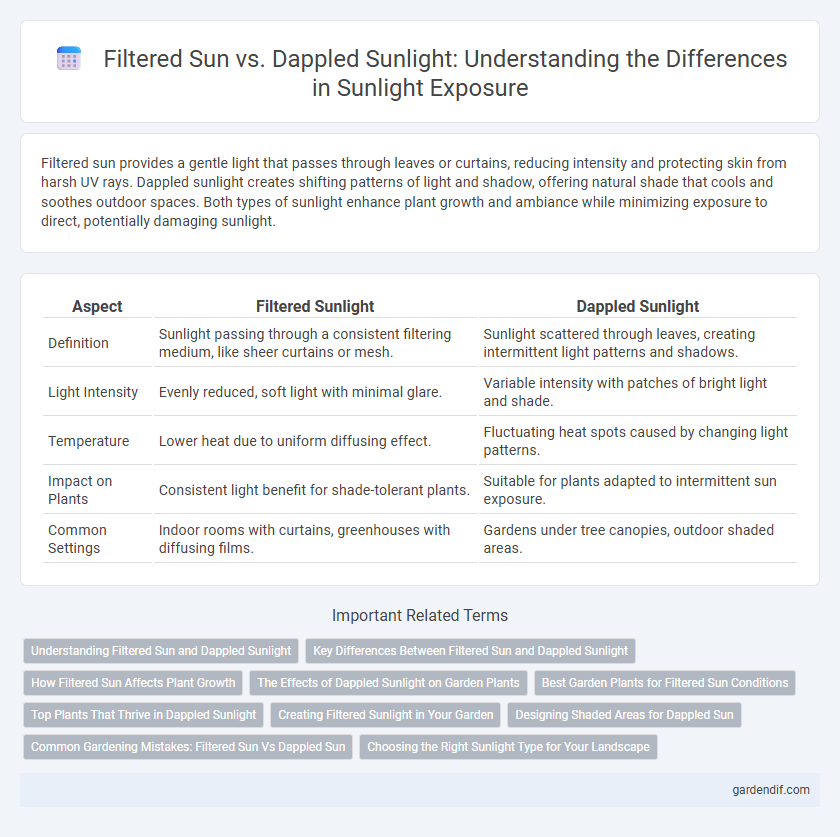
Filtered sun vs dappled sunlight Illustration
Filtered sun provides a gentle light that passes through leaves or curtains, reducing intensity and protecting skin from harsh UV rays. Dappled sunlight creates shifting patterns of light and shadow, offering natural shade that cools and soothes outdoor spaces. Both types of sunlight enhance plant growth and ambiance while minimizing exposure to direct, potentially damaging sunlight.
Table of Comparison
| Aspect | Filtered Sunlight | Dappled Sunlight |
|---|---|---|
| Definition | Sunlight passing through a consistent filtering medium, like sheer curtains or mesh. | Sunlight scattered through leaves, creating intermittent light patterns and shadows. |
| Light Intensity | Evenly reduced, soft light with minimal glare. | Variable intensity with patches of bright light and shade. |
| Temperature | Lower heat due to uniform diffusing effect. | Fluctuating heat spots caused by changing light patterns. |
| Impact on Plants | Consistent light benefit for shade-tolerant plants. | Suitable for plants adapted to intermittent sun exposure. |
| Common Settings | Indoor rooms with curtains, greenhouses with diffusing films. | Gardens under tree canopies, outdoor shaded areas. |
Understanding Filtered Sun and Dappled Sunlight
Filtered sun refers to sunlight that passes through a semi-opaque barrier such as tree leaves or a sheer fabric, reducing its intensity and creating a gentle illumination ideal for sensitive plants and indoor settings. Dappled sunlight is characterized by patches of direct sunlight interspersed with shade, typically occurring under tree canopies where light is scattered by leaves, offering a dynamic light environment beneficial for shade-tolerant vegetation. Both filtered sun and dappled sunlight provide moderated light conditions essential for preventing leaf scorch and promoting healthy photosynthesis in various plant species.
Key Differences Between Filtered Sun and Dappled Sunlight
Filtered sun passes through a solid medium like curtains or mesh, reducing light intensity and creating a uniform glow, ideal for indoor plants requiring indirect light. Dappled sunlight, found under tree canopies or foliage, features patches of bright light interspersed with shadows, offering fluctuating light levels beneficial for shade-tolerant plants. These distinctions impact photosynthesis rates, temperature regulation, and plant growth patterns, making light selection crucial for gardening success.
How Filtered Sun Affects Plant Growth
Filtered sun provides plants with diffused, indirect light that reduces the risk of leaf scorch while still enabling photosynthesis, promoting healthier growth in shade-tolerant species. This type of sunlight maintains consistent light intensity, which helps prevent stress and dehydration often caused by direct, harsh sunlight. Gardeners often use filtered sunlight environments to optimize moisture retention and nutrient absorption, crucial for the development of sensitive plants like ferns and begonias.
The Effects of Dappled Sunlight on Garden Plants
Dappled sunlight provides garden plants with a balanced exposure to light, combining periods of shade and direct sunlight that prevent leaf scorch and overheating. This filtered light enhances photosynthesis efficiency by reducing stress, promoting healthier growth and vibrant foliage. Many shade-loving plants, such as ferns and hostas, thrive under dappled sunlight, making it ideal for diverse garden ecosystems.
Best Garden Plants for Filtered Sun Conditions
Filtered sun provides consistent, gentle light ideal for shade-tolerant plants like ferns, hostas, and caladiums, promoting lush foliage without leaf scorch. Dappled sunlight, characterized by intermittent light spots through tree canopies, favors plants such as hydrangeas, impatiens, and begonias that thrive with partial shade and periodic light exposure. Gardeners selecting plants for filtered sun conditions should prioritize species adapted to low-to-moderate light intensity to ensure optimal growth and vibrant blooms.
Top Plants That Thrive in Dappled Sunlight
Top plants that thrive in dappled sunlight include ferns, hostas, and hydrangeas, which benefit from the gentle interplay of light and shade. This filtered sunlight creates ideal growing conditions by reducing direct UV exposure and preventing leaf scorch, promoting lush foliage and vibrant blooms. Understanding the specific light requirements of these shade-tolerant plants ensures optimal growth and garden aesthetics in partially shaded environments.
Creating Filtered Sunlight in Your Garden
Filtered sunlight provides consistent, softened light ideal for shade-loving plants, created by strategic placement of trees or lattice structures. Dappled sunlight, characterized by shifting light patterns through leaves, offers variable intensity that benefits plants requiring intermittent light. To create filtered sunlight in your garden, position deciduous trees or install pergolas with climbing plants to diffuse harsh midday sun while maintaining adequate brightness for growth.
Designing Shaded Areas for Dappled Sun
Designing shaded areas for dappled sunlight requires strategically placing trees or lattice structures to create patterns of light and shadow that mimic natural canopy effects. This approach promotes a cooler microclimate while allowing intermittent sunlight to nourish shade-tolerant plants and enhance outdoor comfort. Dappled sunlight supports diverse garden ecosystems by balancing light intensity, preventing plant stress common under fully filtered sun.
Common Gardening Mistakes: Filtered Sun Vs Dappled Sun
Filtered sun provides consistent, gentle light by passing through a translucent barrier like a shade cloth or glass, ideal for plants requiring moderate light intensity. Dappled sunlight, created by sunlight streaming through tree leaves, offers irregular light patches that vary throughout the day, which can stress sun-sensitive plants. Common gardening mistakes include confusing these two light conditions, leading to plant stress or sunburn when intolerant species receive harsh, uneven sun exposure instead of stable filtered light.
Choosing the Right Sunlight Type for Your Landscape
Filtered sun provides consistent, gentle light that reduces leaf scorch and supports a wide range of shade-tolerant plants, making it ideal for dense garden beds and understory plantings. Dappled sunlight offers intermittent light through tree canopies, creating natural patterns that benefit plants requiring moderate sunlight and fostering biodiversity by supporting diverse microhabitats. Selecting between filtered sun and dappled sunlight depends on plant species' light requirements and the desired aesthetic effect, ensuring optimal growth and landscape harmony.
Filtered sun vs dappled sunlight Infographic

 gardendif.com
gardendif.com